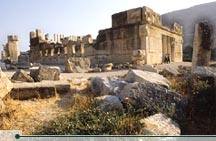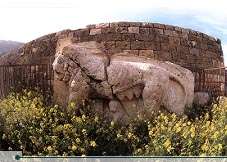 |
Keys
to the Kingdom National Anthem The Office History |
|
 ‘Iraq al-Amir. © Ammar Khammash |
Although the influence of Greek culture had been felt in Jordan previously, Alexander the Great’s conquest of the Middle East and Central Asia firmly consolidated the influence of Hellenistic culture. The Greeks founded new cities in Jordan, such as Umm Qais (known as Gadara) and renamed others, such as Amman (renamed from Rabbath-Ammon to Philadelphia) and Jerash (renamed from Garshu to Antioch, and later to Gerasa). Many of the sites built during this period were later redesigned and reconstructed during the Roman, Byzantine and Islamic eras, so only fragments remain from the Hellenistic period. Greek was established as the official language, although Aramaic remained the primary spoken language of ordinary people. |
| Alexander died soon after establishing his empire, and his generals subsequently struggled over control of the Near East for more than two decades. Eventually, the Ptolemies consolidated their power in Egypt and ruled Jordan from 301-198 BCE. The Seleucids, who were based in Syria, ruled Jordan from 198-63 BCE. |
| The most spectacular Hellenistic site in Jordan is at ‘Iraq al-Amir, just west of modern-day Amman. The Qasr al-Abd (“Castle of the Slave”) there is constructed of very large stones, some of which have sculpted figures of lions and eagles. The Qasr is surrounded by an artificial moat and was probably either a temple or palace, although its small entrance would have made it a significant defensive asset. The “castle” belonged to a governor of Ammon named Hyrcanus, who was also a member of the influential Tobiad family. It was built in the late-second century BCE. |  Marble sculpture of a lioness and her cub. Qasr el'Abed, ‘Iraq al-Amir. © Mouasher |